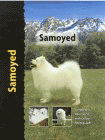
Samoyed (Pet Love)
Samoyeds are exceptionally good looking dogs which have many similarities with Siberian Huskies, Keeshonds and Norwegian Elkhounds. They are long-haired spitz dogs, from Siberia, and are white or cream in colour, with soft undercoats and coarse guard hairs. They don't have such tightly curled tails as Keeshonds and Elkies, and their 'trousers' aren't as long as those of Keesies, but Samoyed owners are quite likely to be stopped in the street, since these dogs attract attention by looking stunning.
They are a little larger, more serious, and less clownish than Keeshonds, and are friendly, without being as demonstrative as Keesies or Sibes. Samoyeds are more difficult to train than Keesies and Elkies, in the sense that it's more difficult to motivate Samoyeds, but they do learn fast, and are versatile dogs. They were developed to perform a range of tasks, including livestock guarding and herding, as well as pulling sleds. They were also bred to be family dogs, so usually behave well with people. Samoyeds can attach themselves more to one person in a household, while being friendly with everyone else. They do need to be socialized well with people, or they can be a bit barky at strangers, but well-trained Samoyeds are usually friendly with visitors who their owners let into the house. Like all spitz dogs, they need to have house rules set out from when they are pups, and consistency is important for training them. Well-trained Samoyeds usually get on very well with children because they are generally calm, tolerant and gentle, and they are usually sociable with other dogs, generally enjoying canine company, especially the company of other spitz dogs. There is sometimes friction between dogs of the same sex, so it's safer to get opposite sex dogs if you have more than one Samoyed. A mix of a Samoyed and a smaller breed spitz of the same sex can also work well, though let the dogs meet first to see how they get on, if you decide to bring an adult dog into a household which already has a Samoyed.
Samoyeds need to be given something to do, or they tend to bark, chew, and otherwise become difficult. They make good agility dogs, and walking companions, though they should not be exercised in the heat of the sun in summer, due to their thick coats. Like Keeshonds, they need more grooming than the short-haired spitz dogs, though not as much grooming as many long-haired breeds. They also don't get as dirty as you might expect, though they will need a good towelling after a muddy walk!
They are generally clean dogs and easy to housetrain. Like Keeshonds, Samoyeds tend to bark a lot, though this can be managed to some extent, using methods similar to those described for Keeshonds. Samoyeds can be good watchdogs in that they give alarm barks, but they are quite likely to behave in a friendly way with an intruder who greets them, so aren't good guard dogs. They aren't the easiest breed for a novice, but much depends on whether owners are prepared to give them enough to do, and be firm and consistent with very cute fluffball pups, only giving rewards, like opening the door for walks, when the pup is behaving properly, sitting quietly, for example, rather than leaping around like a dervish.
The Japanese Spitz is very similar to the Samoyed, but smaller, and is an easier option for someone new to spitz dogs who wants a cute-looking white fluffy dog. Generally, Samoyeds are healthy dogs, like most spitzes, but they can suffer from hip dysplasia, diabetes, and skin problems, such as allergies.
This is a good guide for Samoyed lovers, with a lot of stunning illustrations of this handsome breed. There is a lot of information on the history of Samoyeds, and help with general care, including health care.



